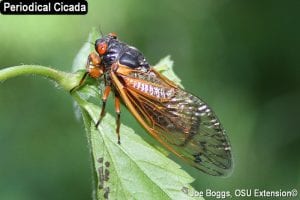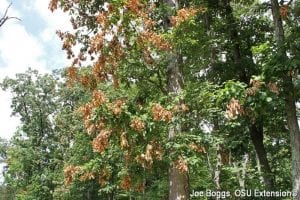2021 will be a massive cicada year. Already this year we have gotten a swarm (get it?) of questions regarding cicadas and how they will affect your home landscape. Billions of cicadas will emerge this May in the Miami Valley after living most of their lives underground. They will emerge for a few weeks to mate, lay eggs, and eventually die. Sounds terrible, but we need to separate this image from plagues of locusts devouring all foliage and blackening the sky. Cicadas are not locusts. Fortunately a cicada’s 100 decibel bark is worse than its non-existent bite.
Cicadas damage plants when the females use their ovipositors to pierce small branches to lay their eggs. They prefer small deciduous trees simply based on size and ease of reaching an ideally sized branch. They will also avoid evergreens, since evergreen sap will smother the egg and sometimes the mother. The weakest branches usually turn brown and hangs from the rest of the living branch which is called “flagging”.  Then the eggs fall to the ground to begin their 17 year lifecycle underground.
Then the eggs fall to the ground to begin their 17 year lifecycle underground.
So what should a homeowner do? Simply put, you do not have to do anything. Although our plant warranty does not cover cicada damage, we don’t suggest that all young trees need to be protected. Cicada damage very rarely kills a plant. The most likely scenario is that lower branches on many new and established trees will die, but the tree almost always survive the damage. Our Nursery Field Manager Rhett Johnson says “We grow thousands of trees at our Beavercreek nursery and expect damage, but very few losses”.
Some trees warrant protection.
– memorial trees
– high profile trees
– newly planted trees that show signs of stress
– symmetrical and highly manicured and formal trees
These trees and plenty of others should be protected to preserve all of their branches and give them the best chances moving forward. To protect them, we recommend using cicada netting on smaller trees. These nets are available online and at both garden centers, which also have other orchard netting for abnormally sized trees and areas. Simply wrap and use the included zip ties to protect throughout cicada season.
Don’t hesitate to reach out to our garden centers for additional assistance. Thanks to the great Joe Boggs, OSU extension entymologist for pics.
Robert Siebenthaler
President- The Siebenthaler Company
Certified Arborist OH-5241A



 Then the eggs fall to the ground to begin their 17 year lifecycle underground.
Then the eggs fall to the ground to begin their 17 year lifecycle underground.